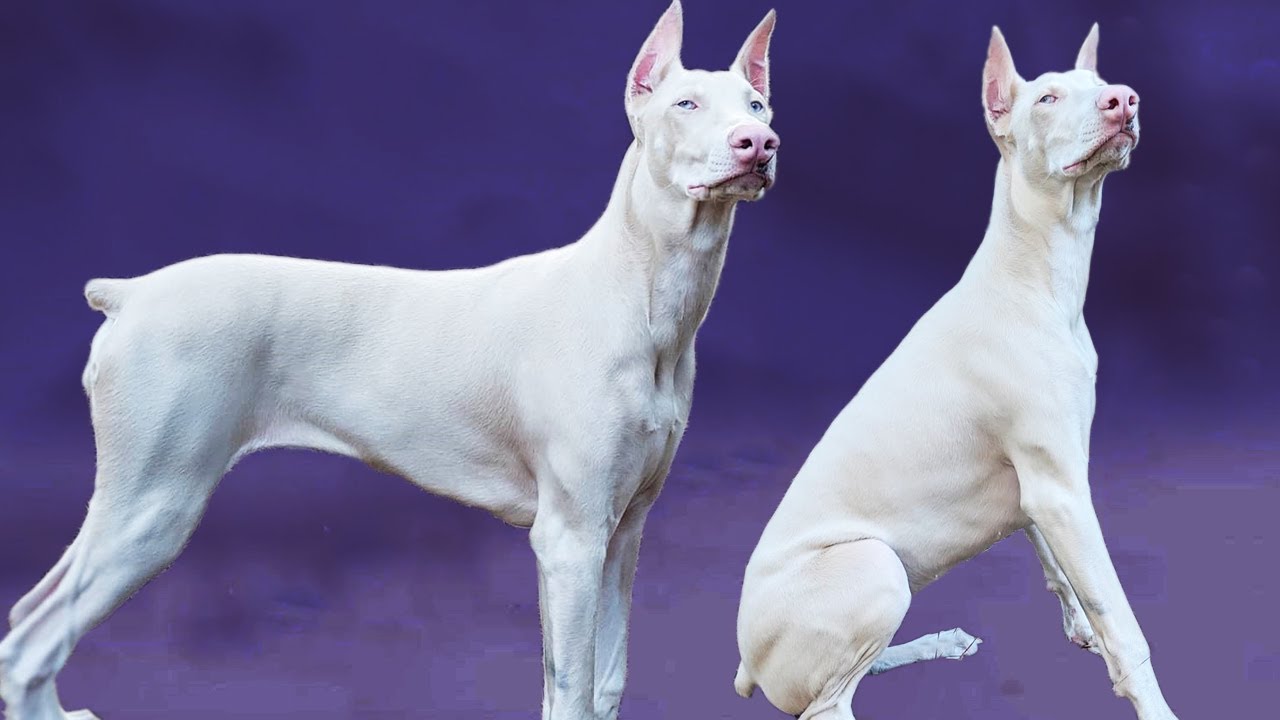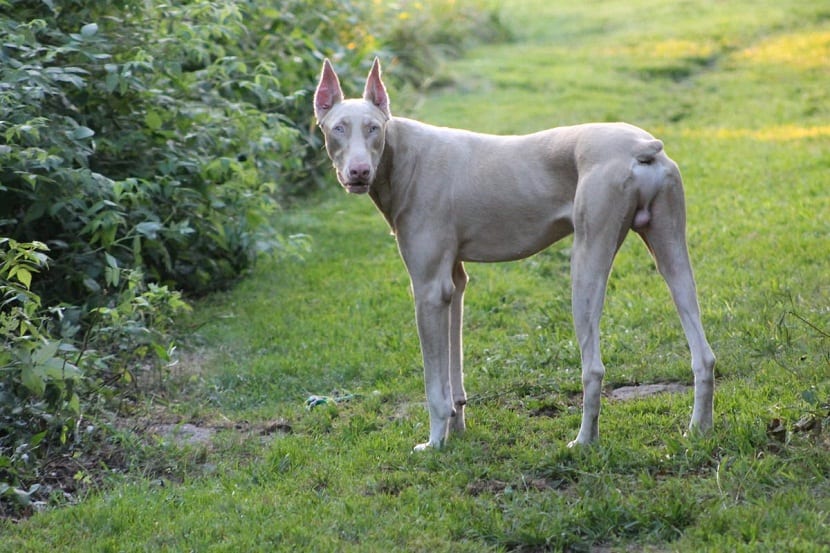
Many people who are unfamiliar with Dobermans do not know the existence of the white or cream-colored Dobermans. They often find themselves confused or surprised at the breed and don’t know what to call it. Although they don’t really have the full albino status, these dogs are often called “albino Dobermans”. However, it’s easy to see why someone new to them would think so due to their light coloring.
There is much controversy surrounding the white Doberman. Many believe it’s unprofessional to breed this Doberman color for health reasons. So, I decided to dig deep into the topic and review the most recent research on white Dobermans. This section contains information about albino status, history, and health, as well as costs and other details.
Albino vs. White Dobermans
We need to first discuss what these dogs are and aren’t. Professionals are still arguing about whether these dogs can be considered albinos. Here’s what we know so far.
White Dobermans have a light cream color and white markings. They have pink eyes and lips. They aren’t albinos, but they do have some pigmentation. For example, blue eyes can only be achieved with some pigmentation. If there is no pigment, the eyes would appear pink. The fact that white Dobermans can be considered “tyrosinase-positive Albinoids” is widely accepted. This is an albinism type, but it’s not the one you and I think of.
These dogs may be called “albino”, but it is possible to get some looks from Doberman professionals who are familiar with the Doberman world. Because many Doberman professionals believe you are referring to traditional full-albino dogs, which they are not. If you really want to be precise, you could refer them as “tyrosinase positive albinoids”, but I think it’s easier to refer to them simply as “white Dobermans” and “cream Dobermans.”
Due to the traditional genetic mutation which causes albinos in animals, it is genetically possible to have full-albino Dobermans. However, a true “full albino” Doberman has not been found. Because there is no pigment in a full-albino Doberman, you can easily tell the difference. A white Doberman will have blue eyes
Histories

Padula’s Queen Sheba, also known as “Sheba”, was the first Doberman of white to be registered with American Kennel Club (AKC). Both her parents were black and rust-colored on November 10, 1976. Her pedigree bears the words “first white Doberman not laid to sleep” written on them. This suggests that other white Dobermans were born before her. This mystery remains unsolved, but there are some references to a “light-colored Doberman” in literature dating back at least to the 1930s.
Initial doubts arose about Sheba’s purebred Doberman Pinscher. After the owner provided sufficient evidence to support the claim, Padula’s Queen Sheba became an AKC-registered Doberman Pinscher in 1978.
Sheba was later bred together with her son, and the son was bred along with his sisters in an effort to preserve this genetic trait. All known Doberman Pinschers of white color have descended from Sheba.
The DPCA Albino Doberman history page provides a fascinating first-hand account of how the white Doberman was first known to exist.
Genetics
Dogs have a mix of black and red pigments (Eumelanin and Phaeomelanin). Each dog’s genetic makeup will determine the amount of each pigment in their coat and how to dilute it is. This results in all the colors we’re used to seeing on the Doberman Pinscher, such as black (Isabella), red (Isabella), and blue (Isabella).
Now it is known that the white Doberman is a result of a different recessive genetic that masks the final color that would otherwise have been produced by normal genetic processes. This gene is a mutation of the SLC45A2 genetic code. The source gene has a significant portion of its genetic code missing. Although the result is somewhat representative of albinism, the correct term is not yet known. In other animals, this same mutation has been shown to cause OCA4 (or Oculocutaneous albinism Type 4).
A Doberman who carries one copy of the mutant gene is considered a “carrier”. If they have two, they will be considered affected by the mutation and will be white or cream in color. To make this Doberman color possible, you will need two copies of the mutated gene.
You can easily test your Doberman’s DNA for the mutant gene using a simple kit.
This means that if you breed two SLC45A2 carriers, the offspring will be 25% white or cream-colored.
Researchers believe this mutation occurred at least five generations before Sheba, since her parents were carriers. This gene mutation was likely passed down from one common ancestor.
Puppy prices

As with any item on the free market, the price of these dogs is not based on what they “should” be sold for but rather what the breeder thinks they can sell the dogs for. These dogs are likely to be sold at a wide range of prices.
In preparation for this article, I reached out to several owners and breeders of white Dobermans. Here’s what I found out about the average price of these dogs.
| White Doberman Puppy Price | |
|---|---|
| Minimum Price | $800 |
| Maximum Price | $2500 |
| Average Price | $1600 |
Note: These are the prices that owners actually paid for white Dobermans. These amounts have been rounded up to the nearest hundred dollars.
Remember that there are many factors that can influence the price of a white Doberman pup, such as location, title, registration status with kennel clubs, ears cropping, and so forth.
Many people believe these puppies should not be more expensive than a typical Doberman. Breeders will continue to advertise these dogs as “rare” and justify a higher price. They are definitely less common than other colors but there are many breeders who specialize in them and buyers can easily find multiple sources to purchase one.
Health Concerns
White Dobermans have additional health issues. Some health issues may arise due to the low levels of pigment in white Dobermans.
- Sunburn– White Dobermans can get sunburned due to their low pigment. Dog-friendly sunblock is recommended for extended exposure to direct sunlight, especially on the nose. You may also need to limit your time outside in the sun.
- Tumors One study found a significant increase of skin cancers in white Doberman pinschers compared to standard colors. In the study, 12 out of 20 White Dobermans had tumors. In this study, each white Doberman above the age of five had at least one cancer. These tumors can be either cancerous or benign, and most of them are likely to be.
- Vision The white Doberman’s iris (the colored part of their eyes) is not pigmented so more light can reach their retina. The dog will often squint when exposed to bright light. While some owners opt to purchase tinted goggles that are dog-specific, others say it is unnecessary.
- Other Concerns– White Dobermans can also be affected by the same health problems as any other Dobermans. These include gastric dilatation, volvulus syndrome (GDV, bloat), hip dysplasia (DCM), chronic activate hepatitis(CAH), von Willebrand’s Disease (vWD), cervical vertebral instability (Wobbler Syndrome), progressive renal atrophy (PRA), hypothyroidism and osteosarcoma. You can find more information about the health issues of Dobermans at.
White Dobermans require a greater commitment to their care and time. You should consider factors such as direct sunlight, sunscreen, and any other concerns.
A DNA health test is the best way to find out about your dog’s overall health. This is an easy process you can do by yourself. You can find out what your dog can expect in terms of health. It’s so frustrating to watch the years pass by without knowing what lies ahead.
You can find my guide to health testing your Doberman, which will give you some ideas on how to go about doing this DNA testing.
Inbreeding

Inbreeding within white Doberman lines is a major concern. It is well known that the American Kennel Club (AKC), the first white Doberman registered with them, was later bred by her to her son. Her son was then bred directly to her sisters. All known white Dobermans today are thought to descend from these first few.
The main concern is not always with the original breeding that created the white Doberman. Many are worried about the possibility of inbreeding in recent generations. This article will discuss more the issue in the “controversy” section. It is believed that inbreeding is widespread by unprofessional breeders who want to produce more white-colored Dobermans. This is possible in certain circumstances. However, it’s also possible that backyard breeders inbreed standard-colored Dobermans for different reasons (or simply because they don’t know how to do so).
Life Expectancy
10-13 Years
There have not been any studies or large data collections that offer insight into the longevity and health of white Dobermans compared to other Doberman colors. This topic is best covered by the study “A partial gene deletion of SLC45A2 causes Oculocutaneous albinism in Doberman Pinscher Dogs”. It does show a higher incidence of potentially cancerous skin tumors in white Dobermans (12% of 20 white Dobermans had such tumors, whereas only 1 percent of standard-colored Dobermans had them). It is worth noting that the 20 Dobermans used in this study are very small.
The current life expectancy of the white Doberman is 10 to 13 years or the same as that for standard-colored Dobermans. However, no studies have shown an increase in mortality or a shorter lifespan.
DPCA, White Dobermans
The Doberman Pinscher Club of America is a member club of the American Kennel Club (AKC). This is the AKC’s only Doberman-specific club. The DPCA stated that it doesn’t condone white Dobermans being bred. The DPCA states that the dog is an unacceptable specimen due to photosensitivity (or photophobia) and health issues. They will not encourage the breeding of this breed.
The DPCA changed its breed standard for Doberman Pinschers in 1982 to allow four colors. These four colors are: black, red and blue Dobermans with rust-colored markings. According to the breed standard, a white patch on the chest that does not exceed 1/2 inch is permissible. Disqualifying Fault: Dogs of an unallowable color. The full breed standard can be found.
This means that any dog with more than half an inch of white on their chest will be disqualified from confirmation shows. The law also stipulates that dogs of any prohibited color will be disqualified. The white Doberman will be ineligible for participation in breed confirmation shows. The white Doberman is still eligible to compete in all companion events, including agility, rally, tracking, and obedience.
Official stance of the DPCA is that these dogs shouldn’t be bred. Breeders need to ensure that they don’t breed dogs with this pedigree. Parents who have had white puppies or are carriers will not be allowed to breed pups from them. This is also known as the “Z-List”.
White European Dobermans

FCI (Federation Cynologique Internationale), a worldwide kennel club, is well-known and deals extensively with European Dobermans. The FCI does not accept white fur as a recognized color in the breed standard. FCI disqualifies any Doberman with white fur.
According to the FCI Doberman breed standard, “The Doberman is bred in two colours: black or brown with red rust, clearly defined markings (tan marks)” and “white spots” is listed as a disqualifying defect. Any deviation from the standard will be considered a defect. The FCI has only allowed two colors for Dobermans: black and brown (or red), with rust-colored markings. The complete FCI breed standard is available.
The FCI has never had to worry about the white Doberman, as it has never been a problem in European Doberman lines. This color seems only to be for American Doberman Pinschers. I’ve spoken with some breeders of other colors who have stated that they are now introducing European bloodlines to their white Doberman breeding programs to diversify the genetic mix.
The “Z-List”.
The Doberman Pinscher Club of America maintains the Z-List. This club tracks all descendants of Padula’s Queen Sheba, the first white Doberman to be registered. This list also includes any other white Dobermans who have been registered with the DPCA. These dogs receive a registration number that begins with “WZ”. You can find the complete list at the DPCA Albino ZList page.
However, it is possible that there are many Dobermans who have the gene mutation. This is because the note on the pedigree of the “first” white Doberman stated “first white Doberman not put into sleep.”
Noting that the mutant gene can only be passed to 50% offspring means that each generation has a half chance of getting it. This list is likely to contain a lot of dogs who aren’t carriers of the mutant gene.
Robert Loechel (VetGen Veterinary Genetics Services Chief Scientific Officer) performed genetic testing on standard-colored dogs that were on the ZList. He found that only 21.25% were carriers of the mutation.
The DPCA has claimed that all known white Dobermans are descendants of Z-List dogs. They will keep using this list to track Sheba’s descendants.
White Doberman Controversy
Most of the Doberman controversy centers around the ownership and breeding of white Dobermans. Both sides have Doberman experts with decades of experience who can help you understand the breed.
Arguments in favor of White Doberman Breeding
Here are the main arguments that are most frequently used by people who support breeding and owning white Dobermans.
- Albino Status – White Dobermans do not qualify as full-albinos. They do not have completely white hair or pink eyes, but they do have some pigmentation. To cast a negative stigma around these dogs, the term “albino”, is used unfairly.
- General Health Health is a serious concern because white Dobermans are so stigmatized that breeders of such colors are more likely to test their dogs for health than those of standard-colored Dobermans.
- Inbreeding There was inbreeding at the beginning of the creation of white Dobermans, but the extent of that inbreeding is unknown in current generations. It is equally or more concerning to see standard-colored show Dobermans being bred to relatives in the United States. This can lead to a genetic bottleneck. Recent inbreeding is a result of unprofessional breeders, and not the dog’s coat colour.
- Skin Issues Blue and fawn-colored Dobermans have more skin problems that white Dobermans because of color dilution alopecia.
- Temperament Problems There are many responsible breeders who use “alternative colors” to dobermans, even the white. Bad breeding practices can cause temperament problems in dogs. This is not the fault of the breeder.
- Bright Sunlight Problems (Photosensitivity). – Bright sunlight can affect other animals and people with blue eyes just as much as it does the blue-eyed Doberman. Dobermans should not consider blue eyes in humans or other animals a “defect”.
- Other Eye-sight Problems Many white Doberman owners will have their dog CERF certified by the Canine Eye Registration Foundation. This certification verifies that the dog is healthy from any potential inherited eye conditions. This certification is easy for white Dobermans.
Arguments against breeding white Dobermans
These are the main arguments used by people who oppose breeding or owning white Dobermans.
- Albino Status – Geneticists have shown that the white Doberman was created by a gene mutation in SLC45A2, which has been proven to cause Oculocutaneous Albinism Type 4. Albinism can take many forms and not all of them produce pink-colored eyes. This dog is an albino.
- General Health These dogs are in poor health because of issues like sunburn and an increased risk of skin cancer.
- Inbreeding White Dobermans are known for their long history of inbreeding to produce more white Dobermans. It is difficult or impossible to prevent inbreeding within their genetic lineage because the genetic pool is so small.
- Temperament Problems These dogs are subject to ongoing temperamental issues due to inbreeding. Breeders have limited breeding stock, so they choose mating pairs based on genetic traits that are likely to produce white puppies. This is not because they are temperament matches.
- Eye-sight Problems These dogs are sensitive to bright light, and often have poor vision in other situations. Fear biting can result. This can lead to fear biting.
- Medical Care Owning these dogs can mean more responsibility (such as wearing sunscreen, goggles and clothing outdoors, and limiting exposure to the sun) and higher chances of costly medical bills.
Last Thoughts
In researching and writing this article, I used information from scientific sources, official sources, as well as unofficial sources. I also had multiple phone conversations and numerous conversations with experienced breeders of alternative colors. This article contains information that was generally agreed upon by both parties. The “White Doberman Controversy”, section will address the main points of contention.
This article was written to introduce people to the white Doberman and help them make a decision about whether to breed or owning these dogs. Although I tried to be impartial, many people have asked what my opinion on cream-colored Dobermans (or white Dobermans) is.
Although I strongly believe that a Doberman of any kind should be born, it should receive the same love and care as any other Doberman. As I think both sides have valid arguments, I don’t hold a strong opinion on whether these dogs should be bred. This is why I will leave it up to you, my readers to decide.
Similar Questions
What is the average lifespan of white Dobermans? It is not known if white Dobermans, also called albino Dobermans, live longer than other colors. Dobermans live between 10 and 13 years on average.
What is the cost of a white Doberman? Doberman puppies that are white (or albino), can be purchased for anywhere from $800 to $2500, with an average cost of $1500. Pricing of Doberman puppies can be affected by many other factors than color.
Are white Dobermans hearing impaired? White Dobermans do not have a higher risk of hearing loss than Dobermans any other color. Although it was once believed that white Dobermans could be deaf, this theory has been disproven.
Are white Dobermans allowed to be AKC registered White Dobermans can be AKC registered? A “WZ” designationator will be attached at the beginning of each registration.